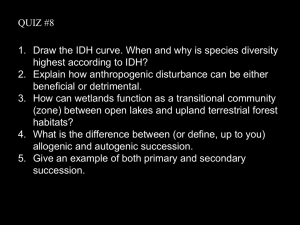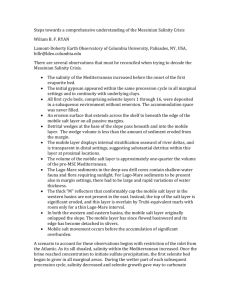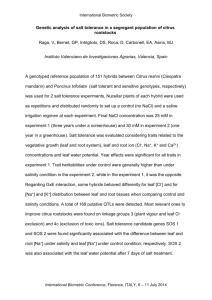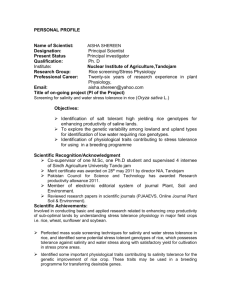Mechanisms of salt tolerance in plants. - Plant-salt
advertisement
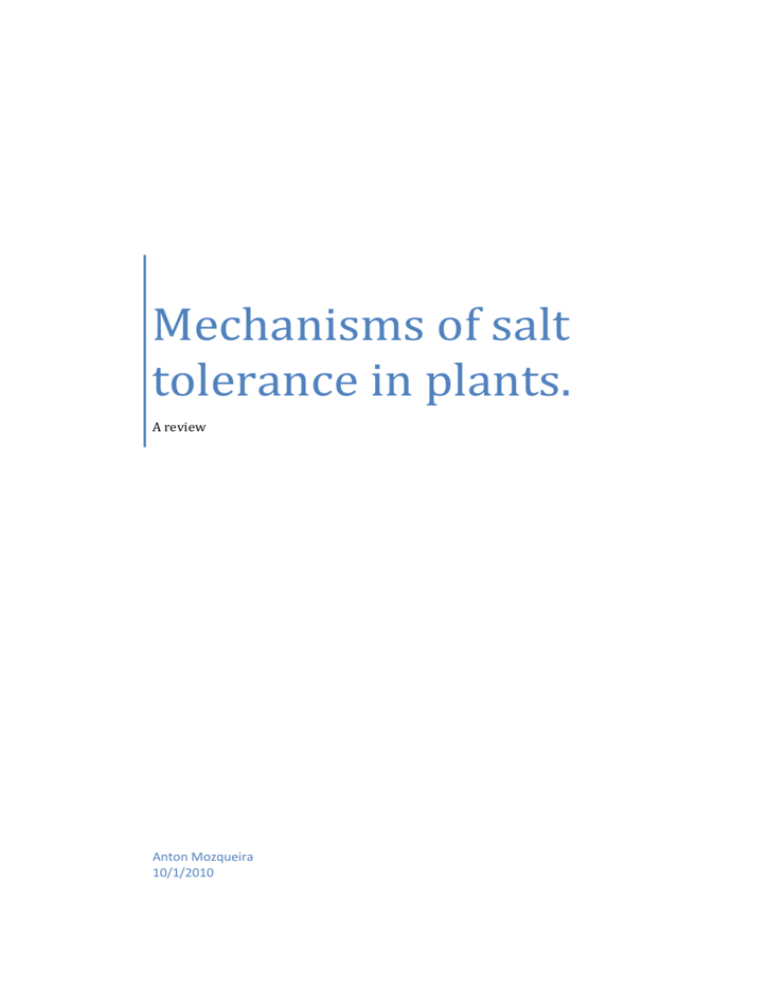
Mechanisms of salt tolerance in plants. A review Anton Mozqueira 10/1/2010 Anton Mozqueira Communication in Science Mechanisms of crop salt tolerance. The problem of salinity tolerance in plants, especially those used as crops, is not a new one. Dry-land salinity caused by irrigation, the removal of tress and the raising of the water table affects around 2,223,948,433 acres of land worldwide(Colmer, Flowers & Munns 2006). This area will continue to grow as the amount of irrigated land increases because there is a strong link between irrigation and salinisation (Flowers 2004). Most of the important crops that we rely on are salt intolerant, and growing them on saline soils reduces yields or completely prevents growth. With the world population and the amount of irrigated land increasing, the development of salt tolerant crops will become crucial if we are to continue to produce sufficient amounts of food (Flowers 2004). Farmers, plant breeders and most recently scientists continue to grapple with the problem of creating a plant that is capable of being grown under saline conditions without the sacrifice of those traits that make it useful as a crop plant (Cheeseman 1988). The reason for this is found in the complexity of a plants response to salt stress, with mechanisms operating cooperatively at many levels of the plants physiology, some of which remain to be fully investigated (Flowers 2005). This review explores some of those natural mechanisms employed by plants with reference to their presentation in the literature. There are two main types of plants relative to salinity tolerance; they are halophytes and glycophytes; those which can thrive in saline conditions and those which can’t (Parida, Das 2005). Halophytes are able to tolerate and in some cases require the presence of salt whereas glycophytes don’t. Both types of plants use the same kinds of mechanisms to deal with salt, but halophytes are more proficient at doing so (Yokoi, et al 2002). All plants require some salts, especially potassium to function properly, (ASHRAF et al. 2008), but excessive concentrations of salts, particularly of sodium and chloride disrupt the plants growth in several ways. Too much sodium or chloride is harmful to the plant because it reduces its uptake and transport of water by changing the osmotic potential of the plants cells (Parida, Das 2005). If there is too much salt outside the plants cells then the salt holds all the water so that the plant cannot take any in. When the plant tries to adjust its osmotic potential by taking in large amounts of salt, high concentrations can develop in sensitive areas, such as the cytoplasm and chloroplast (Flowers 2005). High concentrations of sodium or chloride will disrupt these cells function and inhibit the plants growth. Plants which maintain high transpiration rates during salinity stress are less tolerant (Flowers 2004). Transpiration, or the process of the plant exchanging oxygen for carbon dioxide, requires that more water be taken into the plant, to replace what was lost to evaporation. This process consumes more water during the day than when carried out at night. Because the plant requires more water, greater amounts of salts will be absorbed with the water by the plant. The ability to adjust transpiration rates and times will make a plant more tolerant (Gorham, Jones & McDonnell 1985). Anton Mozqueira Communication in Science Mechanisms of crop salt tolerance. Another problem caused by high salinity is the production of reactive oxygen species (ROS) in the chloroplast, mitochondrion and peroxisome (Ashraf 2009). They include super oxide, hydrogen peroxide, hydroxyl radical and singlet oxygen (Ashraf, Akram 2009). They are a product of the plants metabolism and are a normal component of the plants chemistry (Ashraf 2009). They are only harmful in higher concentrations, a result of the stress caused by high salinity (Ashraf, Akram 2009, Apse 2002). Because less salt tolerant plants do not normally produce enough anti-oxidants to scavenge all of the ROS produced under these conditions, the reactive oxygen species will try to pair their single oxygen with other elements to form a more stable compound. To complete this pairing, the ROS can break down important molecules such as proteins, lipids, and nucleic acids within the cells (Ashraf 2009). High levels of salinity also inhibit the plants growth by limiting or preventing membrane transportation of nutrients from the ground to the plants cells (Ashraf et al. 2008). Because there are high levels of sodium and chloride in the soil it is hard for the plant to select for potassium and other useful ions over the more abundant sodium and chloride ions(Flowers 2004). This means that the plant will not receive sufficient nutrition to complete its metabolic functions for growth, and that for any small amount of nutrition it receives, a large amount of salt will have accumulated in its tissues. Plant photosynthetic activity also decreases due to increased salinity (LI et al. 2008). Because the plant tries to limit the loss of water through evaporation by closure of the stomata, it is unable to exchange carbon dioxide for oxygen. This means that the plants growth rate will be severely limited or stop altogether because it does not have any new carbon to metabolise into the carbohydrates which it uses to grow (Parida, Das 2005). This lack of oxygen exchange also leads to the development of excessive amounts of oxygen in the chloroplast, leading to the formation of reactive oxygen species or ROS, which lead to a further reduction of photosynthesis (Ashraf 2009). High salt content within the plants cells also leads to the disruption of many complicated metabolic processes necessary for photosynthesis (Flowers 2005). Thus far the effect of high salinity on plants has been presented. Now the mechanisms used to deal with high salinity will be examined. Plants employ many mechanisms at many levels of their physiology in order to tolerate salinity. They try to employ several simpler mechanisms cooperatively before altering the function of major processes such as photosynthesis (Parida, Das 2005). Plants that can regulate their intake of sodium and chloride are able to continue functioning and grow unimpeded in highly saline environments (Flowers 2004). Sodium and potassium share the same transporter protein, called the Na +/K+-ATPase, so it is easy for sodium to be over selected for when it is in higher concentrations (Apse 2002). Sodium/potassium transporters in halophytic plants are more selective than those in glycophytes (Apse 2002). Another method of entry is the slow vacuolar (SV) ion channels. These do not select for Anton Mozqueira Communication in Science Mechanisms of crop salt tolerance. specific ions and so allow a large amount of ions in when there are high external concentrations (Ashraf, Akram 2009). It has been found that in halophytic plants, slow vacuolar ion channels are open much less than glycophytic ion channels and so prevent indiscriminate admission of unwanted ions, leading to increased tolerance. Plants that can actively select for ions are able to transport them to the vacuole, away from the sensitive metabolic functions of the cytoplasm (Apse 2002). Here they help the plant maintain its osmotic potential in highly saline soils, allowing it continue to access water and nutrients in the ground (Flowers 2005). This function allows the plant to continue to grow. Some plants also specifically fill developed and older tissues and leaves with salt before allowing them to fall off the plant, helping to maintain ionic balance within the plant if growth rates alone are not sufficient (Parida, Das 2005). Plants exposed to many different types of stresses produce compatible solutes (Ashraf et al. 2008). These solutes are produced by the plant and help to preserve the function of enzymes within the cytoplasm when there are high concentrations of sodium in its tissues ( Yokoi et al. 2002). They can also help prevent ROS from damaging plant cells by reacting with them (Ashraf et al. 2008). The most common compatible solutes made by plants are glycinebetaine, mannitol and proline (Flowers 2005). When the plants photosynthetic processes are disrupted and reactive oxygen species begin to damage the plant, anti oxidants and detoxifying enzymes are produced (Ashraf 2009). These help to scavenge and reduce the impact of the reactive oxygen species. Their increased production is an indicator of salt tolerance in a plant. Some of the anti oxidants produced are ascorbate, glutathione, a-tocopherol, and carotenoids, and the detoxifying enzymes include catalase and peroxidase(Apse 2002). Salt tolerance in plants can also be attributed to their ability to alter transpiration rates and times (Flowers 2004). A shorter transpiration period, or opening of the stomata only at night allows the plant to continue growing without losing too much precious water to higher evaporation rates during the day. This type of transpiration is called crassulacean acid metabolism or (CAM) and is only displayed naturally in halophytic plants, such as Mesembryanthemum crystallinum(Parida, Das 2005). Some halophytes have developed specialized organelles, such as salt excreting glands, to help regulate the amount of sodium in their tissue, when it cannot be compensated for by growth rates alone(Flowers 2005). Salt excretion glands show strong preference for specific ions such as sodium, over useful ions like potassium, so that the plant does not waste this important nutrient (Parida, Das 2005). Other plants allow salt to accumulate in old or developed tissues, away from important new growth areas. Once the tissue is full of salt it is allowed to drop off, thereby removing the salt and maintaining ionic balance within the plant (Parida, Das 2005). Anton Mozqueira Communication in Science Mechanisms of crop salt tolerance. Flowers (1997, 2004, 2005) identifies in several of his reviews of the literature that many researchers claim increased salt tolerance in their plants after the transferral of one or two genes in order to over express a single trait. He dismisses their claims and points to lack of commercially viable salt tolerant crops as his evidence and proposes that yield is a better indicator of tolerance than the ability to simply survive(Flowers 2004). Although it would be more convenient for a single trait to confer tolerance, all of the mechanisms above can be found working together in halophytic plants to help them tolerate saline conditions, with many, many genes controlling them (Flowers 2005). In order for a commercially viable, salt tolerant cultivar to be produced, most or all of these traits would have to be transferred to confer tolerance and the maintenance of high yields. Flowers proposes that the development of halophytic plants into crops, particularly those halophytic grasses in the same family as wheat, the Triticea, might be a new direction that could lead to success in this area(Colmer, Flowers & Munns 2006, Flowers 2004). Other researchers suggest that the development of a more complete understanding of the complex genetics responsible for all the traits, and use of more advance gene identification and transferral techniques will result in increased success(Ashraf, Akram 2009). As the pressures of food demand and salinisation of farmable land mount, increased resources and energy will be devoted to this problem and a re-evaluation of the potential of existing halophytic species as crop plants might be necessary. In the meantime, the methods of exogenous application of compatible solutes, as well as increasing the amounts of calcium and potassium in saline soils as identified by (Ashraf et al. 2008), might be a temporary solution for traditional crop plants. Anton Mozqueira Communication in Science Mechanisms of crop salt tolerance. References Apse, M. 2002, "Engineering salt tolerance in plants ", Current opinion in biotechnology, vol. 13, no. 2, pp. 146 - 150. Ashraf, M. 2009, "Biotechnological approach of improving plant salt tolerance using antioxidants as markers ", Biotechnology Advances, vol. 27, no. 1, pp. 84-93. Ashraf, M. & Akram, N.A. 2009, "Improving salinity tolerance of plants through conventional breeding and genetic engineering: An analytical comparison ", Biotechnology Advances, vol. 27, no. 6, pp. 744-752. ASHRAF, M., ATHAR, H., HARRIS, P. & KWON, T. 2008, "Advances in Agronomy Volume 97; Some Prospective Strategies for Improving Crop Salt Tolerance ", vol. 97, pp. 45 - 110. Cheeseman, J.M. 1988, "Mechanisms of Salinity Tolerance in Plants", Plant Physiology, vol. 87, no. 3, pp. 547 -550. Colmer, T.D., Flowers, T.J. & Munns, R. 2006, "Use of wild relatives to improve salt tolerance in wheat ", Journal of experimental botany, vol. 57, no. 5, pp. 1059-1078. FLOWERS, T. 2005, "Why does salinity pose such a difficult problem for plant breeders• ", Agricultural Water Management, vol. 78, no. 1-2, pp. 15-24. Flowers, T.J. 2004, "Improving crop salt tolerance ", Journal of experimental botany, vol. 55, no. 396, pp. 307-319. Gorham, J., Jones, R.G.W. & McDonnell, E. 1985, "Some mechanisms of salt tolerance in crop plants ", Plant and Soil, vol. 89, no. 1-3, pp. 15 - 40. LI, N., CHEN, S., ZHOU, X., LI, C., SHAO, J., WANG, R., FRITZ, E., HUTTERMANN, A. & POLLE, A. 2008, "Effect of NaCl on photosynthesis, salt accumulation and ion compartmentation in two mangrove species, Kandelia candel and Bruguiera gymnorhiza ", Aquatic Botany, vol. 88, no. 4, pp. 303 -310. Parida, A.K. & Das, A.B. 2005, "Salt tolerance and salinity effects on plants: a review ", Ecotoxicology and environmental safety, vol. 60, no. 3, pp. 324-349. Shuji Yokoi, Ray A. Bressan and Paul Mike Hasegawa 2002, "Salt Stress Tolerance of Plants.", JIRCAS Working Report, [Online], vol. 2002, no. 23;PAGE.25-33(2002), pp. 9/29/2010. Available from: http://sciencelinks.jp/j-east/article/200212/000020021202A0337724.php. [9/29/2010].



